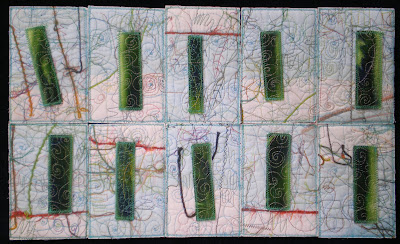 I've been a member of Postmark'd Art for years. You can read about the project, see lots of fantastic fiber art postcards, and read articles at the website. (Check out my article on working with heliographic prints!) We are on Round 7 of exchanges, and it just keeps getting better and better. (You can read more about this group and Art2Mail in my interview with The Alliance for American Quilts.) This time around I committed to making my postcards out of recycled materials.
I've been a member of Postmark'd Art for years. You can read about the project, see lots of fantastic fiber art postcards, and read articles at the website. (Check out my article on working with heliographic prints!) We are on Round 7 of exchanges, and it just keeps getting better and better. (You can read more about this group and Art2Mail in my interview with The Alliance for American Quilts.) This time around I committed to making my postcards out of recycled materials.As I work in the studio, I keep a sample quilt next to my machine. It consists of two layers of muslin sandwiching some of my favorite batting. I use it to check thread tension when loading a new thread, to audition stitching motifs, to experiment with couching on threads and yarns, and so on and so forth. Once I have things to my satisfaction I move on to the actual quilt at hand. When the sample quilt gets filled up, I make a new one, but I am always reluctant to toss the old one because there is a lot of interesting, if random, stitching on it.
So this time around I recycled it. I layered it with tulle (recycled from alterations at a bridal shop) to hold down all the loose threads and did some more stitching. I cut it up into the 4" x 6" card format, and added raised motifs. The motifs were the trimmings from the "Canopy of Leaves" cards I had done several years ago, and had saved because I thought they might prove useful. Also because I just liked them.
Here's one of the new cards:
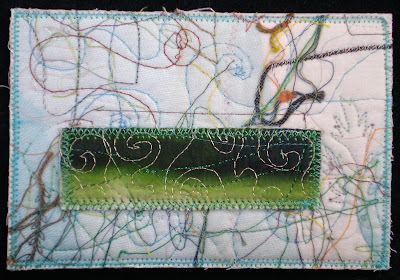 One of the nice things about the being a Postmark'd Art participant, along with the camaraderie and the thrill of cool art showing up in my mailbox, is that it provides an impetus to try out concepts in a small format. As I am currently deeply ensconced in working on not one but two Very Large Quilts, I enjoyed a quick side trip into something achievable in a short time frame. I also enjoyed the departure from my usual stylistic themes. I don't usually work with abstract images, and had fun with the brief flirtation.
One of the nice things about the being a Postmark'd Art participant, along with the camaraderie and the thrill of cool art showing up in my mailbox, is that it provides an impetus to try out concepts in a small format. As I am currently deeply ensconced in working on not one but two Very Large Quilts, I enjoyed a quick side trip into something achievable in a short time frame. I also enjoyed the departure from my usual stylistic themes. I don't usually work with abstract images, and had fun with the brief flirtation. Is it art? Quite possibly. It has lines and forms and colors and a focal point. Is it Art with a capital A? Could be--it expresses an concept, even if the concept is simply "let's see what I can make that is interesting/pleasing with materials at hand". At any rate, they are finished and mailed off to all sorts of exotic ports of call, and that's enough.
Is it art? Quite possibly. It has lines and forms and colors and a focal point. Is it Art with a capital A? Could be--it expresses an concept, even if the concept is simply "let's see what I can make that is interesting/pleasing with materials at hand". At any rate, they are finished and mailed off to all sorts of exotic ports of call, and that's enough.Here's one of the "Canopy of Leaves" cards that the motifs were trimmed from:

And here's a few more of the Recycled cards:



 The subtleties of the color combinations give me such a thrill--and look what happens when they are paired with a piece of dupioni silk I already had on hand:
The subtleties of the color combinations give me such a thrill--and look what happens when they are paired with a piece of dupioni silk I already had on hand: These are for an upcoming project that is still in the cognitive stages. Stay tuned!
These are for an upcoming project that is still in the cognitive stages. Stay tuned!
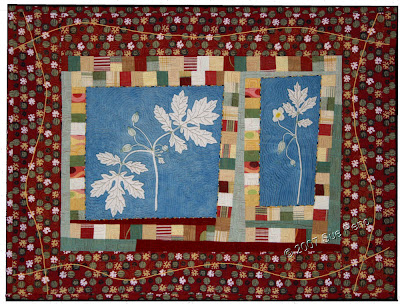


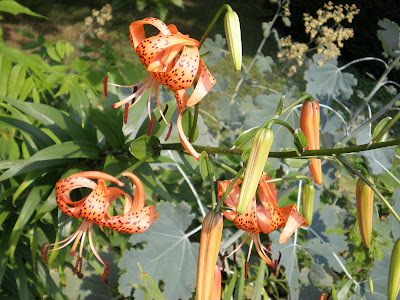
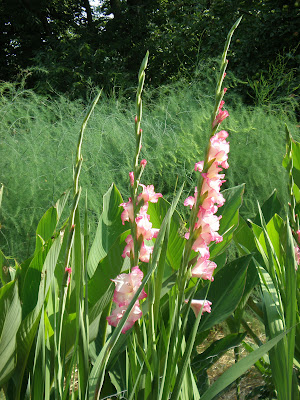 Both of these plants are pleasing and commonly grown because they are visually engaging--they are satisfyingly large. You know you've got something worthwhile when the display catches your eye from a distance. It's also important that when you get up close, there's lots of detail in the shapes and colors and markings to hold your interest.
Both of these plants are pleasing and commonly grown because they are visually engaging--they are satisfyingly large. You know you've got something worthwhile when the display catches your eye from a distance. It's also important that when you get up close, there's lots of detail in the shapes and colors and markings to hold your interest.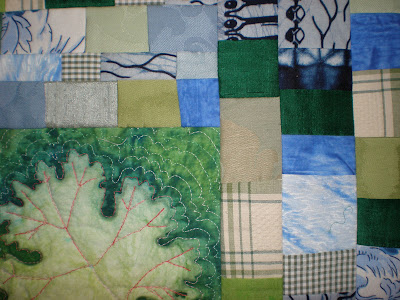

 Stripy Italian eggplants, shown here in with vintage
Stripy Italian eggplants, shown here in with vintage 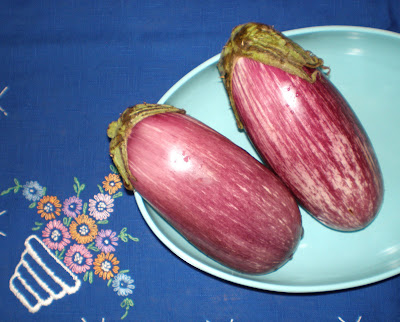 Two varieties of sugar plums--these are bite-sized plums that are amazingly sweet without being cloying--better than candy, and eagerly anticipated each summer:
Two varieties of sugar plums--these are bite-sized plums that are amazingly sweet without being cloying--better than candy, and eagerly anticipated each summer:
 And bi-color sweet corn for supper:
And bi-color sweet corn for supper: I've been fortunate to live in farming country most of my life, with access to locally grown food, so it's just been a way of life for us. I'm so glad to see the concept of eating locally is gaining in popularity--small produce farmers work incredibly hard, and deserve our support and our food dollars.
I've been fortunate to live in farming country most of my life, with access to locally grown food, so it's just been a way of life for us. I'm so glad to see the concept of eating locally is gaining in popularity--small produce farmers work incredibly hard, and deserve our support and our food dollars. 



 The fennel is blooming heavily. I enjoy snipping bits to cook with, but mostly I grow it because it is such a good bee attractant--if you squint, you can see a few in this picture:
The fennel is blooming heavily. I enjoy snipping bits to cook with, but mostly I grow it because it is such a good bee attractant--if you squint, you can see a few in this picture: And once the bees are drawn to the fennel, they make side trips over to the bean blossoms to fertilize them--this is a lovely purple flowered variety. The beans are purple as well, but turn green when cooked:
And once the bees are drawn to the fennel, they make side trips over to the bean blossoms to fertilize them--this is a lovely purple flowered variety. The beans are purple as well, but turn green when cooked: I grow obedient plants mostly just for the novelty--each blossom is on something akin to a ball bearing, so if you have a lot of time on your hands, you can swivel them about and they will stay where you put them--hence the "obedient". They attract a type of small bee with a green sheen to its abdomen, that crawls deep into the blossom:
I grow obedient plants mostly just for the novelty--each blossom is on something akin to a ball bearing, so if you have a lot of time on your hands, you can swivel them about and they will stay where you put them--hence the "obedient". They attract a type of small bee with a green sheen to its abdomen, that crawls deep into the blossom: The
The 
 Last but not least, the
Last but not least, the 
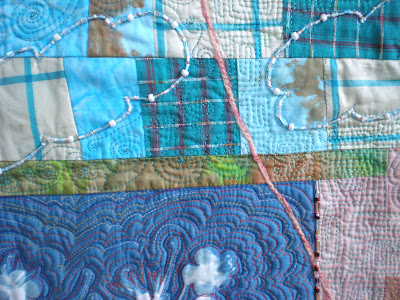

 I've used the leaves in a lot of fiber postcards and collages, they were one of the plants I used in
I've used the leaves in a lot of fiber postcards and collages, they were one of the plants I used in  All of my hard work and focus, however, pales by comparison to the endeavors and dedication of a pair of
All of my hard work and focus, however, pales by comparison to the endeavors and dedication of a pair of 
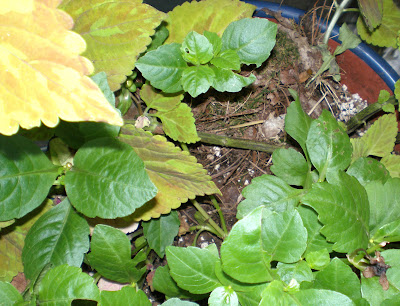 I love wrens, not only for their perky demeanor and beautiful song, but because they consume huge quantities of insects. My garden is free of bean beetles for the first time in recent memory, and I'm sure the proximity of the wrens has a lot to do with it. I can see them darting to and from with little insect bits hanging from their beaks, and it does my heart good.
I love wrens, not only for their perky demeanor and beautiful song, but because they consume huge quantities of insects. My garden is free of bean beetles for the first time in recent memory, and I'm sure the proximity of the wrens has a lot to do with it. I can see them darting to and from with little insect bits hanging from their beaks, and it does my heart good. 
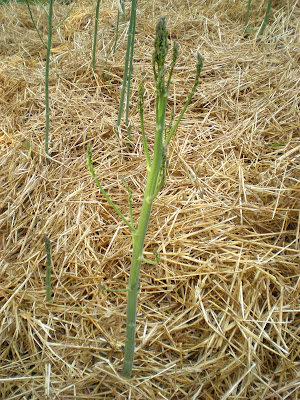
 And here's the asparagus bed last week. ( In the foreground are gladiolas and cannas.) The fronds will get fuller and taller as the summer progresses, topping out at about 6 ft. After frost in the fall they will slowly turn brown. In late winter I will cut them back and compost them, and the cycle will being again.
And here's the asparagus bed last week. ( In the foreground are gladiolas and cannas.) The fronds will get fuller and taller as the summer progresses, topping out at about 6 ft. After frost in the fall they will slowly turn brown. In late winter I will cut them back and compost them, and the cycle will being again.



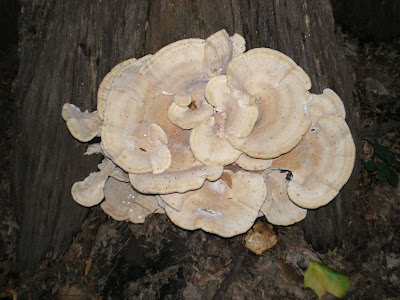 Those little spots are a small flying insect that feeds on the fungus--I haven't been able to identify them yet:
Those little spots are a small flying insect that feeds on the fungus--I haven't been able to identify them yet: Here's the
Here's the 


 And another detail, showing the cloud shapes:
And another detail, showing the cloud shapes: Next up, the binding, and then I can start in on the beadwork. Stay tuned!
Next up, the binding, and then I can start in on the beadwork. Stay tuned!